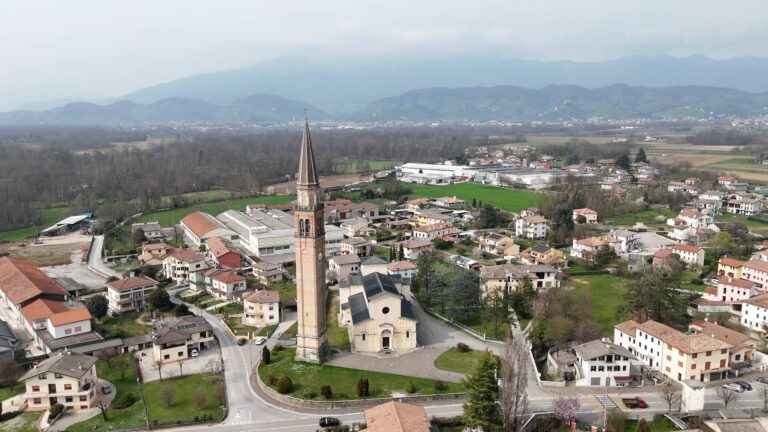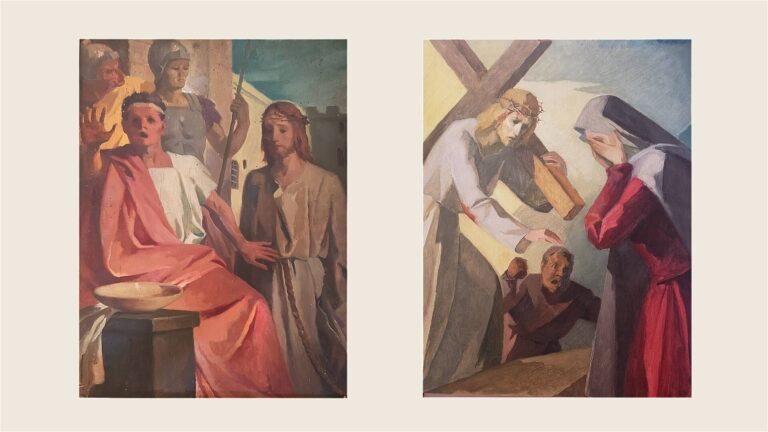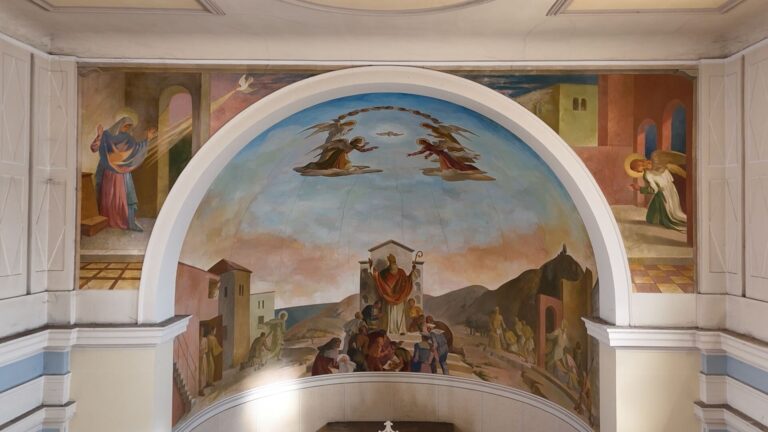ARTISTS’ ROADS
LE VIE DEGLI ARTISTI
watch the videos at the bottom of the page!
SERNAGLIA DELLA BATTAGLIA
1) DUE ARTISTI, DUE EPOCHE, DUE LINGUAGGI
2) FALZE’ DI PIAVE
3) FONTIGO
1) Sernaglia della Battaglia
Two Artists, Two Eras, Two Languages To Express The Sacred
The River Piave is the backbone of these lands. An ancient artery for trade, a source of sustenance.
In the autumn of 1917, in the wake of the Caporetto defeat, its wide, gravelly bed becomes a bloody theatre of war. It brings devastation to the riverside villages.
Sernaglia will henceforth be called Sernaglia della Battaglia, a name that becomes a monument in itself, lest we forget.
The parish church is reduced to rubble.
The Belluno-born architect Alberto Alpago Novello is commissioned to design the new one. By 1922, the construction is complete.
But a new image of the Virgin is needed for this space dedicated to her.
In 1928, the task is entrusted to the artist Carlo Donati, who also paints the altarpieces for the four side chapels.
Born in 1874, he is a renowned painter, trained in Verona, then a “city of vibrant stylistic and intellectual exchange”. His work is an original blend of ancient and modern, of Renaissance art and Art Nouveau atmospheres. He handles both small panel paintings and vast, complex mural cycles with equal mastery.
And here is his Assumption for the high altar.
Mary is dressed like a bride of the time. A veil frames her face, and her billowing white gown envelops her.
She ascends into heaven, borne aloft in a ring of angels. They lift the edges of her fine organza as if they were flawless page boys.
Below, the apostles gather around the empty tomb. Standing side by side, like a single body. Gazing upwards, they are spellbound by the vision. Their garments are richly detailed, the fabrics abundant. They wear elaborate frisé hairstyles, wildly fashionable and particularly favoured by Donati.
But the altarpiece sparks debate. It is praised for its “inspiration, layering, delicacy and softness” but criticised because “the figures are too evanescent; the Virgin should be dominant, and the angels less crowded, more joyful and triumphant”.
Such is often the fate of art: it demands time to be understood.
The controversy drags on, and the painter from Verona will never complete the mural decoration that had initially been planned to accompany his work in this church.
A twist in the tale. In 1945, the archpriest Don Luigi Balasso commissions a new altarpiece, “…to replace,” the record says, “the current one on the high altar”.
This time, the artist is Giuseppe Modolo of Santa Lucia di Piave. He is 33 years old and has cultivated his calling as a painter alongside a sculptor, his fellow townsman Riccardo Granzotto, today Blessed Brother Claudio. And Bepi, as he often signs himself, seems to sculpt with colour.
His Assumption arrives in Sernaglia in 1949. He respects the iconographic tradition. Modolo has Titian’s Frari altarpiece in mind. A more familiar and recognisable composition.
Mary is solid, soaring against a break in the golden sky. A shaft of light floods a patch of cloud. Its whiteness sets off the red of her robe, the blue of her mantle.
On earth, the apostles are seized by a whirlwind of emotion. John, in the centre, seems like the needle of a scale. Another burst of blinding light. It illuminates the burial cloth that one of the twelve is lifting from the empty tomb.
Another twist. Even this second painting will not take the central position.
Today, both altarpieces are mounted on the lateral walls of the sanctuary. Each mirrors the other. Over three metres high. Monumental.
A compelling and distinguished dialogue between two artists, two eras, two languages, each expressing the same truth of faith.
MORE EXPERIENCES!
Vis à vis: Artisti a confronto:
- Tiziano e Francesco da Milano nel duomo di Serravalle
- Strati di affreschi nella pieve di San Pietro di Felletto
- Fra’ Claudio e la sua immagine nell’arcipretale di Santa Lucia di Piave
- Francesco da Milano e Francesco Frigimelica a Sant’Andrea di Bigonzo, Serravalle
2) Falzè di Piave (Sernaglia della Battaglia)
Within History: The Way of the Cross at Falzè di Piave
“Dearest friends,
Having returned home for good after five months spent in Falzè creating the monumental work of the Way of the Cross, I feel compelled to send Don Piero and yourselves my deepest and most heartfelt thanks for offering me the chance to realise a work that had accompanied me for years, through my journeys across Italy and abroad, as a hope and a certainty that one day I might leave in the church of Falzè the very best of my hard-won experience.
Your church was, as they say, my first love. I began with the angels bearing grace and peace, and I ended with the certainty of the Resurrection.
Creazzo, 16 December 1972.”
These were the words of painter Bepi Modolo, written to Don Pietro Velo, parish priest of Falzè di Piave, and to his collaborators, together with his Christmas greetings.
Words that speak of a profound bond with the place, and with the people.
It was Don Pietro himself who, in 1948, first commissioned him. A fresco of the Crucifixion for the counter-facade. At that time, the walls were still white in that sacred building, proudly facing the River Piave, designed by the architect Domenico Rupolo of Caneva after the Great War.
Over time, the painter returned to develop, little by little, a true iconographic programme.
The Way of the Cross was to be its worthy, monumental culmination.
The Passion of Christ was a theme dear to Modolo. From his youth. But in Falzè, it would take on a wholly new and original meaning.
He pondered it for years. He conferred with Don Pietro.
They exchanged letters, even clippings from the daily press. What they saw in those pages were the dramas of the day: ongoing conflicts, injustice, acts of barbarity that, even in the early 1970s, still bled across the world. On those two long white walls, still blank, still to be inscribed, the Passion must resound in its universal value. A story for everyone, of all people, of all time.
The vast space invited ambition.
The first sketches were born.
Then came the models: two extraordinary panels, each two metres wide. The vision gradually took form. “From now on,” Modolo would say, “everything is clear. All I have to do is to move my hands.”
He, a clear soul, free from pretence, dedicated to sacred painting and to the sacredness of his craft, was a master of technique. In the tradition of the greats, he painted strictly in buon fresco. Lime and sand, mixed with coloured pigments, became storytelling. The result is direct, essential, suffused with golden light, suspended in time.
An invitation to walk, with our own story, along the Via Dolorosa. Time flows on without pause.
Delicate and powerful, the figure of Christ returns, seven times, and seven again. His robe, dazzling white, is already a sign of hope. Flares of brilliant yellow ignite his halo.
The cross moves dynamically. As if captured in a series of frames. But it is a fleeting presence, soon to leave the scene.
In the background unfolds the human story, with its tragedies. The harshness of emigration, the devastation of the Great War— still an open wound for Falzè. The concentration camps of the Second World War, the story of Father Kolbe, a modern-day Simon of Cyrene, and the brutal Nazi reprisals. Other gallows, other burdens to carry.
But in the end, the two paths become one. Humanity, with its story and its suffering, comes face to face with the Risen Christ. And dwells with Him in the Light.
PHOTO 360 FALZE’ Move the mouse over the image
MORE EXPERIENCES!
Ritratti “ti vedo non ti vedo”:
- Guido Cadorin a Moriago della Battaglia
- Marta Sammartini a Pieve di Soligo
- Don Cumano al Santuario di Revine
- Annamaria Trevisan a Lago
3) Fontigo (Sernaglia della Battaglia)
Fontigo and Sailing the Piave under the Protection of Saint Nicholas
Fontigo. The very name of this village, nestled in the heart of the Quartier del Piave, evokes its unique character and its deep, ancient bond with the river.
By the time it reaches Fontigo, the River Piave has already travelled more than a hundred kilometres. Flowing down from the mountains that gave it birth, it gradually softens its pace.
Beyond the narrowing in Vidor, having reached the broad gravel flats of Moriago, the river spreads into a dense tangle of winding branches. And it is precisely at Fontigo that the Piave is reborn, fed by the Fontane Bianche.
Natural springs of astonishing clarity whose fresh, bubbling waters still echo through the silence of this enchanting area. Natural white springs, so called for the limpidity of their waters.
Mirrored pools and patches of woodland dot a classic floodplain landscape, guardian of a precious biodiversity.
Not far downstream, the river flows gently.
For centuries, it served as a major thoroughfare for the floating of timber, using rafts built to carry logs from Cadore all the way to Venice.
These rafts were piloted by skilled raftsmen whose daring voyages led them through rapids and swirling eddies.
For the communities along the banks, the passage of these rafts must have been a sight to behold.
At Fontigo in particular, one can imagine the commotion as crew and passengers prepared for their imminent arrival at the port of Falzé. There, the tired raftsmen, worn out from the journey, would disembark and hand over the raft to a fresh crew, before returning on foot to their native Belluno area.
On their way back, they would stop at local inns, and, upon reaching Fontigo, give thanks to their protector, Saint Nicholas, in the church that bears his name.
That Saint Nicholas, bishop of Myra, in what is now Turkey, who lived between the 3rd and 4th centuries, is better known in Italy as Saint Nicholas of Bari, ever since 1087, when sailors from that Apulian city stole his relics and brought them home.
We do not know what the original church in Fontigo looked like.
We do know that it was already standing in 1224 and that it fell under the mother church of Sernaglia. We also know that it was rebuilt in 1887.
It can be glimpsed in a postcard from 1918, at the end of the First World War.
The church was in ruins. All that remained was the elegant façade. And little else.
The current parish church was erected between 1921 and 1926, based on plans by the engineer Giovanni Schiratti and the architect Alberto Alpago Novello. Between 1949 and 1954, architect Luigi Candiani oversaw the raising of the nave.
But the interior remained bare.
Giuseppe Modolo, a painter from Creazzo with a flair for both small canvases and monumental frescoes, had recently worked in nearby Falzé and Sernaglia. In 1950, he was commissioned by the Fontigo community to devise an ambitious iconographic programme. The scheme culminated in the Annunciation, painted on either side of the triumphal arch, and Saint Nicholas in the apse’s conch.
A first preparatory sketch of the Saint survives. It reflects the final work, with one exception: in the sketch, the artist included a large architectural screen in the fresco, an artifice meant to emphasise the figure of the saint.
Saint Nicholas stands at the centre of the composition, clad in episcopal robes. He blesses the crowd gathered before him: mothers with their children, clergy, youngsters, sailors…
At either side, two scenes from his life unfold. On the left, young Saint Nicholas has just gifted three bags of gold to the daughters of a man fallen on hard times. As he walks away, the grateful father kneels in thanks, with the three girls at his side. They now have a dowry so they may marry.
On the right, Nicholas, now bishop of Myra, saves three innocent men who were about to be executed by order of the governor Eustace. He seizes the sword from the executioner’s hand and bursts into the governor’s palace unannounced.
In the background, mountains and sea frame the narrative.
A photograph from 1950 shows the finished work. What stands out is the sky. Pierced open, revealing the Holy Spirit as a dove descending upon the earth. Sadly, a later alteration would erase this powerful spiritual message.
Fontigo is also associated with two other saints. Not far from the parish church stands the church of Saint Roch, today a war memorial dedicated to the fallen of both world wars. Further down the same road is the oratory of Saint Libera, a popular destination for pilgrims.
(pause)
…not far from here, the river flows on…
PHOTO 360 FONTIGO Move the mouse over the image
MORE EXPERIENCES!
La pittura sacra di Bepi Modolo:
- … a Sernaglia della Battaglia
- … a Falzè
- … a Santa Lucia di Piave
- … a Moriago della Battaglia
MULTIMEDIAL MAP: “ARTISTS’ ROADS – LE VIE DEGLI ARTISTI- EN”!



